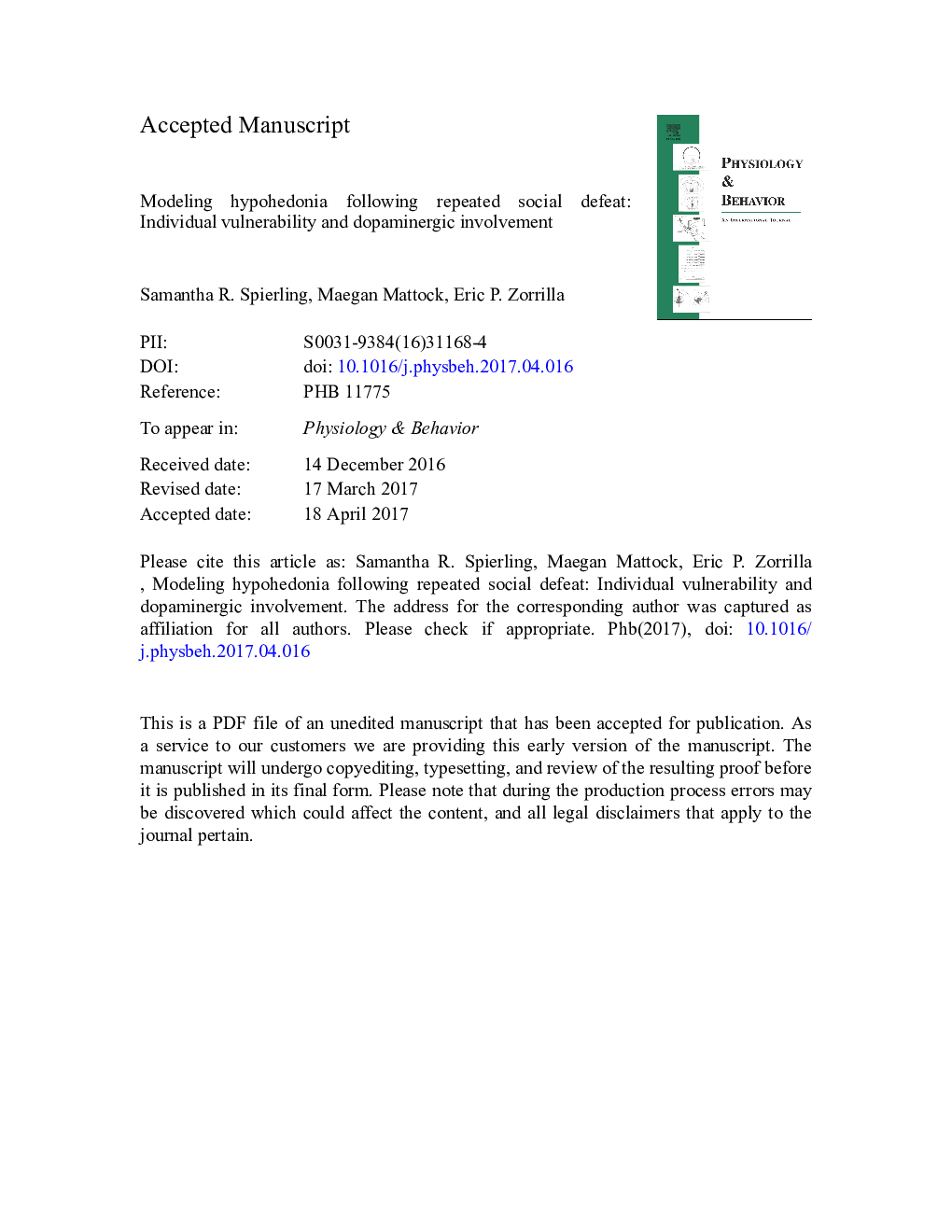| کد مقاله | کد نشریه | سال انتشار | مقاله انگلیسی | نسخه تمام متن |
|---|---|---|---|---|
| 5593729 | 1571142 | 2017 | 29 صفحه PDF | دانلود رایگان |
عنوان انگلیسی مقاله ISI
Modeling hypohedonia following repeated social defeat: Individual vulnerability and dopaminergic involvement
ترجمه فارسی عنوان
مدل سازی هیپو ههومی پس از شکست اجتماعی مکرر: آسیب پذیری فرد و دخالت دوپامینرژیک
دانلود مقاله + سفارش ترجمه
دانلود مقاله ISI انگلیسی
رایگان برای ایرانیان
موضوعات مرتبط
علوم زیستی و بیوفناوری
بیوشیمی، ژنتیک و زیست شناسی مولکولی
فیزیولوژی
چکیده انگلیسی
Social defeat in rodents putatively can model hypohedonia. The present studies examined models for assessing hypohedonia-like behavior and tested the hypotheses that 1) individual differences in baseline reward sensitivity predict vulnerability, and 2) defeat elicits changes in pharmacological measures of striatal dopaminergic function. Male Wistar rats (n = 142) received repeated defeat (3 “triad” blocks of 3 defeats) or control handling. To determine whether defeat influenced consumption of SuperSac (glucose-saccharin) over an isocaloric, less preferred, glucose solution, a 2-choice paradigm was used. To determine repeated defeat effects on the reinforcing efficacy of SuperSac, a progressive-ratio schedule of reinforcement was used. Amphetamine-induced locomotor activity (0.08 mg/kg, s.c.) was determined as a measure sensitive to striatal dopaminergic function. Defeat reduced SuperSac consumption during the first two triads-an effect seen in the third triad only in defeated rats with High vs. Low baseline SuperSac intake. The characteristic escalation in PR breakpoint for SuperSac normally seen in controls was absent in defeated rats, leading to a significant difference by the third triad. Defeat-induced blunting of the escalation in PR performance was greater in rats with High antecedent PR breakpoints and persisted 2.5 weeks post-defeat. Repeated defeat also blunted amphetamine-induced locomotion 13 days post-defeat. Thus, hypohedonic-like effects of social defeat were detected and accompanied by persistently attenuated striatal dopamine function. Early effects were seen for consumption of differentially-palatable solutions, and persistent effects were seen for the “breakpoint” motivational measure. The results implicate initial reward sensitivity as a risk factor for stress-induced hypohedonia.
ناشر
Database: Elsevier - ScienceDirect (ساینس دایرکت)
Journal: Physiology & Behavior - Volume 177, 1 August 2017, Pages 99-106
Journal: Physiology & Behavior - Volume 177, 1 August 2017, Pages 99-106
نویسندگان
Samantha R. Spierling, Maegan Mattock, Eric P. Zorrilla,
